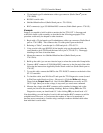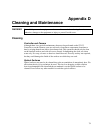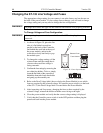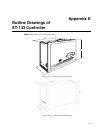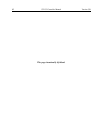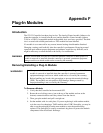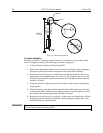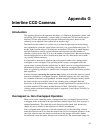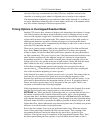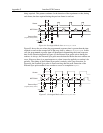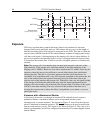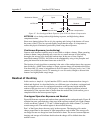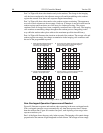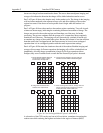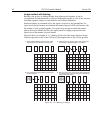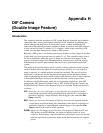
86 ST-133 Controller Manual Version 3.B
each cell of the array is transferred out of the CCD array, amplified, and sent to the
controller as an analog signal, where it is digitized prior to transfer to the computer. .
Note that mechanical shuttering is not required in either mode, although it is available as
an option. Mechanical shuttering allows a much higher on/off ratio to be attained, which
may offer distinct advantages with short exposure times.
Timing Options in Overlapped Readout Mode
Interline CCD sensors have columns of imaging cells alternating with columns of storage
cells. During readout, the charge stored in the photo-sensitive imaging cells move only
one row to the adjacent storage cells. From there they move downwards to the readout
register and from there to the output node. This scheme serves to allow high speeds, no
smearing and shutterless operation, a distinct advantage over frame-transfer sensors
where the cell contents can be contaminated by the charge in other cells as data is moved
across the CCD and under the mask.
There are two timing options available in the overlapped mode, Free Run and External
Sync. Select None as the Shutter Type if using WinView/32 software and operating
without a shutter. In both Free Run and External Sync operation, the array photosensors
see light continuously. The actual exposure time is the time between data transfers from a
photo-sensitive imaging cell to the adjacent storage cell, and may be longer than the
programmed exposure, t
exp
. Data transfer from the photo-sensitive imaging cells to the
storage cells occurs very quickly at the start of each readout. During the read, the stored
data is shifted to the array’s readout register and from there to the output node.
In Free Run overlapped mode operation, the imaging cells are exposed for the set
exposure time (t
exp
). Then the data transfer to the storage cells takes place, marking the
start of the read and the beginning of a new exposure.
In the External Sync mode, overlapped operation only is provided. The camera reads out
one frame for every External Sync pulse received, providing the frequency of the
External Sync pulse does not exceed the maximum rate possible with the system. A sync
pulse must be detected before the subsequent readout can occur. If operating without a
shutter, the actual exposure time is set by the period of the sync signal. There is one
exception as described in the following paragraph.
If the programmed exposure time is less than the readout time in the External Sync mode,
then the actual exposure time is simply equal to t
R
,
the readout time (marked by
NOTSCAN low). More specifically, if the readout time, t
R
, is greater than the sum of t
w1
,
the time the controller waits for the first External Sync pulse, plus t
exp
, the programmed
exposure time, plus t
c
, the shutter compensation time (zero with None selected as the Shutter
type), then the actual exposure time will equal t
R
. If an External Sync pulse is detected during
each read, frames will follow one another as rapidly as possible as shown in Figure 44. In the
figures that follow, Shutter indicates the programmed exposure time. If a shutter were present
and active, it would also be the actual exposure time.
Prior to the first readout, clean cycles are performed on the array. When the software
issues a Start Acquisition command, the first exposure begins. Time counting of the
programmed Exposure Time begins when the sync pulse arrives at the Ext Sync
connector. The exposure ends on completion of the programmed Exposure Time. Then
the data acquired during the first exposure is read out while the next frame of data is



